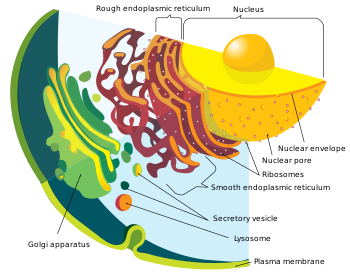
Back نظام غشائي داخلي Arabic Endomembranski sistem BS Sistema endomembranós Catalan Endomembránový systém Czech Endomembransystem German Sistema endomembranoso Spanish دستگاه غشایی درونی Persian Système endomembranaire French Sistema endomembranoso Galician מערכת אנדוממברנה HE

The endomembrane system is composed of the different membranes (endomembranes) that are suspended in the cytoplasm within a eukaryotic cell. These membranes divide the cell into functional and structural compartments, or organelles. In eukaryotes the organelles of the endomembrane system include: the nuclear membrane, the endoplasmic reticulum, the Golgi apparatus, lysosomes, vesicles, endosomes, and plasma (cell) membrane among others. The system is defined more accurately as the set of membranes that forms a single functional and developmental unit, either being connected directly, or exchanging material through vesicle transport.[1] Importantly, the endomembrane system does not include the membranes of plastids or mitochondria, but might have evolved partially from the actions of the latter (see below).
The nuclear membrane contains a lipid bilayer that encompasses the contents of the nucleus.[2] The endoplasmic reticulum (ER) is a synthesis and transport organelle that branches into the cytoplasm in plant and animal cells.[3] The Golgi apparatus is a series of multiple compartments where molecules are packaged for delivery to other cell components or for secretion from the cell.[4] Vacuoles, which are found in both plant and animal cells (though much bigger in plant cells), are responsible for maintaining the shape and structure of the cell as well as storing waste products.[5] A vesicle is a relatively small, membrane-enclosed sac that stores or transports substances.[6] The cell membrane is a protective barrier that regulates what enters and leaves the cell.[7] There is also an organelle known as the Spitzenkörper that is only found in fungi, and is connected with hyphal tip growth.[8]
In prokaryotes endomembranes are rare, although in many photosynthetic bacteria the plasma membrane is highly folded and most of the cell cytoplasm is filled with layers of light-gathering membrane.[9] These light-gathering membranes may even form enclosed structures called chlorosomes in green sulfur bacteria.[10] Another example is the complex "pepin" system of Thiomargarita species, especially T. magnifica.[11]
The organelles of the endomembrane system are related through direct contact or by the transfer of membrane segments as vesicles. Despite these relationships, the various membranes are not identical in structure and function. The thickness, molecular composition, and metabolic behavior of a membrane are not fixed, they may be modified several times during the membrane's life. One unifying characteristic the membranes share is a lipid bilayer, with proteins attached to either side or traversing them.[12]
- ^ Smith AL (1997). Oxford dictionary of biochemistry and molecular biology. Oxford [Oxfordshire]: Oxford University Press. pp. 206. ISBN 978-0-19-854768-6.
- ^ Davidson M (2005). "The Nuclear Envelope". Molecular Expressions. Florida State University. Retrieved 2008-12-09.
- ^ Davidson M (2005). "The Endoplasmic Reticulum". Molecular Expressions. Florida State University. Retrieved 2008-12-09.
- ^ Graham TR (2000). Eurekah Bioscience Collection Cell Biology. University of New South Wales and Landes Bioscience. ISBN 978-0-7334-2108-2.
- ^ Lodish H, et al. (2000). "Section 5.4 Organelles of the Eukaryotic Cell". Molecular Cell Biology. W. H. Freeman and Company. Retrieved 2008-12-09.
- ^ Cooper G (2000). "The Mechanism of Vesicular Transport". The Cell: A Molecular Approach. Sinauer Associates, Inc. Retrieved 2008-12-09.
- ^ Davidson M (2005). "Plasma Membrane". Molecular Expressions. Florida State University. Retrieved 2008-12-09.
- ^ Steinberg G (March 2007). "Hyphal growth: a tale of motors, lipids, and the Spitzenkörper". Eukaryotic Cell. 6 (3): 351–60. doi:10.1128/EC.00381-06. PMC 1828937. PMID 17259546.
- ^ Bryant DA, Frigaard NU (November 2006). "Prokaryotic photosynthesis and phototrophy illuminated". Trends in Microbiology. 14 (11): 488–96. doi:10.1016/j.tim.2006.09.001. PMID 16997562.
- ^ Psencík J, Ikonen TP, Laurinmäki P, Merckel MC, Butcher SJ, Serimaa RE, Tuma R (August 2004). "Lamellar organization of pigments in chlorosomes, the light harvesting complexes of green photosynthetic bacteria". Biophysical Journal. 87 (2): 1165–72. Bibcode:2004BpJ....87.1165P. doi:10.1529/biophysj.104.040956. PMC 1304455. PMID 15298919.
- ^ Volland, Jean-Marie; Gonzalez-Rizzo, Silvina; Gros, Olivier; Tyml, Tomáš; Ivanova, Natalia; Schulz, Frederik; Goudeau, Danielle; Elisabeth, Nathalie H.; Nath, Nandita; Udwary, Daniel; Malmstrom, Rex R.; Guidi-Rontani, Chantal; Bolte-Kluge, Susanne; Davies, Karen M.; Jean, Maïtena R.; Mansot, Jean-Louis; Mouncey, Nigel J.; Angert, Esther R.; Woyke, Tanja; Date, Shailesh V. (24 June 2022). "A centimeter-long bacterium with DNA contained in metabolically active, membrane-bound organelles". Science. 376 (6600): 1453–1458. Bibcode:2022Sci...376.1453V. bioRxiv 10.1101/2022.02.16.480423. doi:10.1126/science.abb3634. eISSN 1095-9203. ISSN 0036-8075. PMID 35737788. S2CID 249990020.
- ^ Campbell, Neil A.; Reece, Jane B. (2002). Biology (6th ed.). Benjamin Cummings. ISBN 978-0-8053-6624-2.